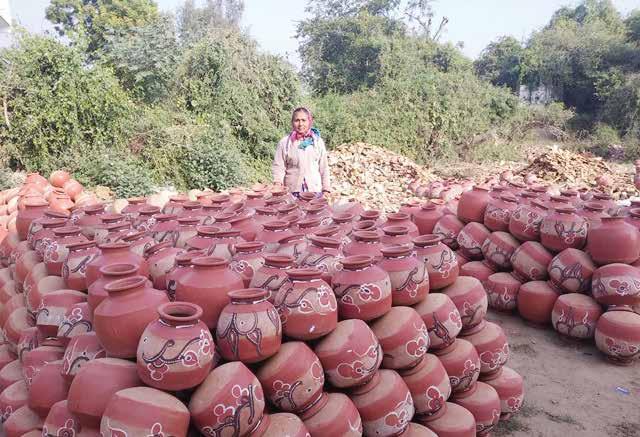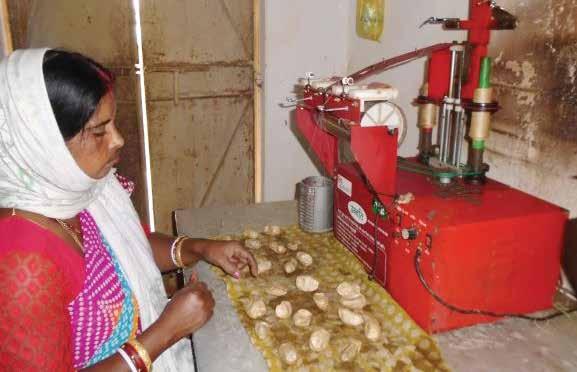
5 minute read
TABLE 3: Electricity bills of powerloom units without subsidy
Production process
The process of weaving a saree or any textile on the powerloom involves sequential steps; first of which is finalizing the design, colour, and material to be used. Next, threads are warped on to the weaver’s beam by skilled artisans. The beam is inserted into the loom and filling or weft threads are interlaced perpendicularly to the warped threads. A jacquard machine in a powerloom helps recreate designs and patterns on the surface of the woven fabric. The final step involves finishing the woven textile using the wax process.
Advertisement
Energy consumption
In the studied cluster, the electrical capacity of motor used in individual powerloom is around 0.75 HP. Thus, for multiple looms operating within the same unit, the cumulative capacities of all motors range from 2.25 HP to 6 HP. All the studied units run their machines for around 10 hours daily. Units with three or four looms in operation consumed between 16 and 22 kWh of power per day, while the larger units having six and eight looms were found to consume 33 kWh and 45 kWh per day, respectively. The monthly electricity charges are subsidized approximately 60% by the Department of Handloom and Textiles (DoHT) of Karnataka to support the powerloom units. The average electricity bill across the units in the studied cluster has been provided in Table 3. Daily power supply has been regular except occasional power cut for around 1–2 hour. The power cut increases up to 2–3 hour in the rainy and summer seasons during which the productivities are partially affected. Though the overall power supply is satisfactory in the region, power generation from solar would further reduce the power subsidy burden of the department. The weavers interviewed in the studied cluster expressed their interest in exploring the option of solar PV to reduce their current electricity bill. They were also willing to provide the available space for installation of the system and make partial capital contribution.
Design of solar PV
In this cluster, grid-fed individual solar PV system has been proposed (without battery back-up) for each and every powerloom unit. The design of the system has been done considering the space constraint and investment capacity of the studied cluster. Thus, it has been assumed that 50% of the energy will be met through solar and the balance 50% will be met through the grid. The solar systems for micro units (3 looms) and small unit (4 looms) have been proposed for 3 kWp and 4 kWp, respectively. Similarly, the capacity for solar system for medium units (6 looms) and large units (8 looms) have been proposed for 6 kWp and 8 kWp, respectively. The area needed for
TABLE 3: Electricity bills of powerloom units without subsidy
Categorization of powerloom unit Monthly average electricity bill (INR) Large (8 looms/unit) 7000 to 9000 Medium (6 looms/unit) 4000 to 5000 Small (4 looms/unit) 3000 to 4000 Micro (3 looms/unit) 2500 to 3000
solar installation for micro, small, medium, and large units are 20 m2, 27 m2, 40 m2, and 54 m2, respectively. Introduction of solar PV across the units is expected to save monthly electricity bill of around INR 1500- INR 4500 (approximately 50% of the current electricity bill) that includes monthly savings of power subsidy which amounts to INR 900–INR 2700 across all units. Thus, power subsidy savings would be around INR 54,000–INR 162,000 if assessed for a period of 5 years. Increase in productivity and revenue due to solar has not been assessed as daily working hours are not expected to increase much except partial gain during summer and rainy seasons.
Proposed business model
To introduce solar in the cluster, financial investment would be needed in the range of INR 162,000 (for three looms) to INR 432,000 (for eight looms). The estimation has been made as per the benchmark price (INR 54 per Wp) of grid-tied roof top solar as notified by MNRE, Government of India. The DoHT, Karnataka, which is the powerloom-promoting agency, can take a lead in arranging maximum subsidy of 40%–55% for incentivizing the entrepreneurs for solar installation so that the department can avoid recurring subsidy burden on electricity. Based on the analysis, the upfront subsidy proposed will be less than the power subsidy for 5–7 years (as per the current rate of power subsidy, i.e. 60%). While 20% would be mobilized from the unit owner, the balance 30% is proposed through loan from commercial bank or other financing institution. The most popular PMMY scheme can be explored for availing Mudra loan. A few scenarios have been worked out considering different proportions of subsidies and bank loans that may be offered to the unit owners, to make the solar system affordable. However, the feasibility of solar has been found only in the following scenarios: In the Belgaum–Khasbag powerloom cluster, as part of this study, the existing units were classified as micro (3 kWp systems), small (4kWp system), medium (6 kWp system), and large (8 kWp system) based on the capacity of a solar PV system that is required to feed their power needs. Without a subsidy component, it was estimated that for each of these categories, a payback period of over 10 years was estimated. In a subsidy model for micro units, with an equity component of 20%, loan of 40% with an interest rate of 12% (5 years) and subsidy of 40% of the total hardware cost of solar PV systems, the payback period is calculated as 5.65 years. The payback period is 5.2 years if the interest rate is reduced to 8% per annum. For small units, with an equity component of 20%, loan of 35% with an interest rate of 12% (5 years) and subsidy of 45% of the total hardware cost of solar PV systems, the payback period is calculated as 5 years. The payback period is 4.65 years if the interest rate is reduced to 8% per annum. For medium units, with an equity component of 20%, loan of 25% with an interest rate of 12% (5 years) and subsidy of 55% of the total hardware cost of solar PV systems, the payback period is calculated as 5.19 years. The payback period is 4.85 years if the interest rate is reduced to 8% per annum. For large units, with an equity component of 20%, loan of 35% with an interest rate of 12% (5 years) and subsidy of 45% of the total hardware cost of solar PV systems, the payback period is calculated as 5 years. The payback period is 4.65 years if the interest rate is reduced to 8% per annum.
Solar potential of cluster
Solar potential has been estimated for business interest of solar manufacturer and suppliers which may further enhance the viability. There are around 1200 powerloom units in the entire cluster. If all the units are solarized, the cluster can provide solar PV potential of around 6.18 MW.
3 The solar potential for each cluster was calculated as: (capacity of solar system, as per proposed solar design) × (total number of units in the cluster)




